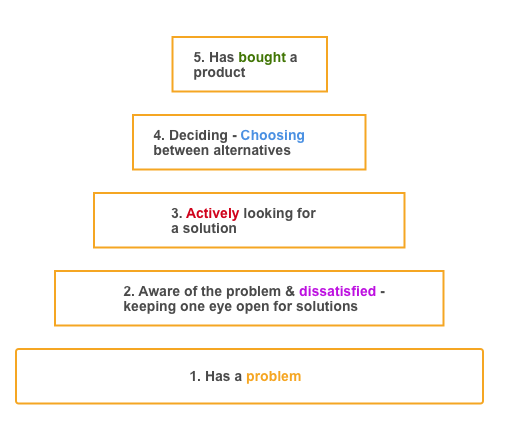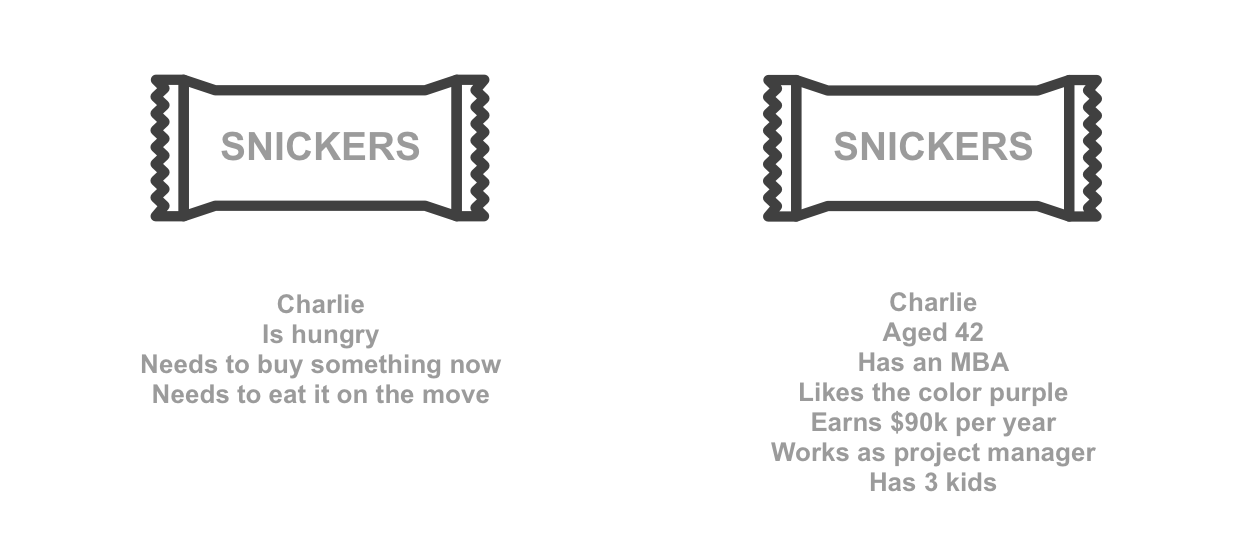The "best" people to interview
Not everyone is a customer. Therefore, it's important when interviewing people to uncover those who really care about the problem and want a solution.
If you interview me tomorrow about surfboards, I might answer your questions. Because I have never been surfing, and I don't intend to learn, my input is at best meaningless and at worse misleading. Consider the best interview subjects as those at the top of the pyramid below - people who have bought your product or a competitor's product recently. They will be able to recall the decision process, major factors, hesitations, and reasons they bought.
Below that are the people who are currently committed to buying something but are considering alternatives. Below that are people who are actively looking into solutions but ultimately may or may not make a purchase. Below that are people who are open to the possibility of a solution. And below that are people who do have the problem, but don't really suffer and would not describe themselves as dissatisfied.

There are two goals to doing customer interviews:
Identify a problem that people really care about solving.
Gain insight into what a solution might look like (the "boundaries" of a solution) and feedback on your solution if you have one.
One way to learn if a problem is painful for someone is to ask how they are solving it today and how they solved it in the past. For example, if a company spent $1 million dollars to fix a problem the last time it happened, then they feel it is worth solving. Unfortunately, people do not care about most products that hit the marketplace. Founders build them because they think they are cool but people do not feel passionately enough to be long-term customers.
Jobs-to-be-done
Customers don't buy features, they buy benefits. Clayton Christensen of Harvard Business School suggests a new way of thinking about this: that customers "hire" products and services to help them to do a job. For example, if you are hungry, you might "hire" a sandwich to satisfy your hunger. The interesting thing about this approach is that it encourages us to think about the scenario and context that caused the customer to take action.

In the diagram above, you can see that when a certain event happened, namely that Charlie was hungry and needed to eat something on the go, he "hired" a Snickers bar. Compare this with all the other information that you know about Charlie (on the right). The jobs-to-be-done theory considers what events trigger a decision in the customer. This is why the customer who has recently purchased is the ideal person to interview - they can recall which events drove them to action. By understanding these events, you understand the customer's job-to-be-done.
When speaking to a customer who made a recent purchase, you can ask questions like:
When did you first start thinking about..
When did you really start looking at solutions to...
When did you know you would make a choice within a certain timeframe?
What made you purchase this product exactly?
These questions encourage the interviewee to share which events prompted their move to the next step of the purchase sequence - and those events help you better understand the customer's job-to-be-done.
Buyer types
Some purchase decisions are individual (like buying an app for my mobile phone). However, some involve a large number of people. For example, if a university wants to buy a new software system, the following people may be involved in the purchase:
Principal buyer: some university members are the key decision-makers.
Financial buyer: certain university staff in the finance department must approve the purchase.
Interested party: university staff who are impacted by the decision and must be consulted. For example, the IT department may have an extra workload if they are going to implement and install a new system.
Ratifiers: although not making the decision, the dean and the board may have to vote to ratify any decision made and can block a purchase at any time.
Users: it may be that the students are the actual end-users of the software system. They may be consulted for their input although the decision will be made on their behalves.
It is important (particularly in B2B products) that the buyer types and their attitudes, ambitions, fears, and anxieties are considered in understanding what represents a viable solution.
At the very least, it is important to make a distinction between the buyer and the end-user when the product/service is bought by an organization on behalf of its members.
Let's recap!
The best people to interview are those who have already purchased a product to try to solve a problem.
There are two goals to doing customer interviews:
Identify a problem that people really care about solving.
Gain insight into what a solution might look like and feedback on your solution if you have one.
It is important to identify the buyer types, their attitudes, ambitions, fears, and anxieties; it may also be important to make a distinction between the buyer and the end-user.
